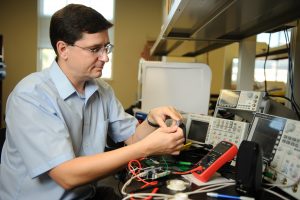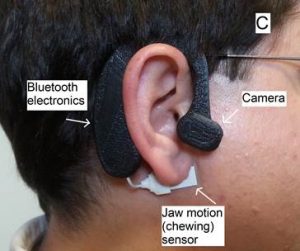
TUSCALOOSA, Ala. — Sensors and software used to track physical activity are increasingly popular, as smart phones and their apps become more powerful and sophisticated, but, when it comes to food, they all rely on the user to report meals.
Dr. Edward Sazonov, an associate professor of electrical and computer engineering at The University of Alabama, hopes to change that through development of a sensor worn around the ear that would automatically track diet, giving medical professionals and consumers accurate information that can be missed with self-reporting.
“Weight gain comes from an unbalance of the energy we take in versus the energy we expend,” Sazonov said. “We can estimate diet and nutrient intake, but the primary method is self-reporting. The sensor could provide objective data, helping us better understand patterns of food intake associated with obesity and eating disorders.”
Sazonov is the lead on a $1.8 million, five-year grant from the National Institute of Health to test the practical accuracy of the wearable sensor in tracking diet. Already proven viable, the device will be updated, further miniaturized and validated in a more formal, robust experiment in the community.
Called an Automatic Ingestion Monitor, or AIM, it has potential to monitor eating by automatically detecting and capturing imagery of food intake and to estimate the mass and the energy content of ingested food.
The sensor feels vibrations from movement in the jaw during food intake, and the device is programmed to filter out jaw motions, such as talking, that are not coming from drinking or eating. Estimates of energy intake would be taken from the pictures of food or drink.
More than two-thirds of adults in the United States are clinically overweight or obese, according to estimates from the Center for Disease Control and Prevention.
“Eating may be an unconscious, even automatic behavior for some individuals, and the literature is full of examples of dietary behaviors which increase the risk for overeating,” Sazonov said.
In a study, the AIM will be tested against the accuracy of an alternative method, the use of a doubly-labeled water to track energy use by humans. That method measures the body’s elimination rate of stable isotopes of hydrogen and oxygen added to the water, a process that can take two weeks. The information can be used to estimate how many calories a person consumes over a period of time.

However, this method is expensive and requires medical specialization, and, unlike the proposed AIM, does not track eating behavior.
The information provided by AIM could be used to improve behavioral weight loss strategies or to develop new kinds of weight-loss interventions. In addition, the AIM could also provide an objective method of assessing the effectiveness of pharmacological and behavioral interventions for eating disorders.
It’s likely the technology’s first application would be as a medical device, but Sazonov said it’s possible it could become a consumer device that would eliminate the need for health-conscious people to keep a record of their diet.
Also on the project are Dr. Megan McCrory, a co-principal investigator and an associate professor of nutrition at Georgia State University, Dr. Janine Higgins, an associate professor of pediatrics at the University of Colorado School of Medicine, and Dr. Jason Parton, assistant research professor of statistics at UA.
Contact
Adam Jones, engineering public relations, 205/348-6444, acjones12@eng.ua.edu
Source
Dr. Edward Sazonov, 205/348-1981, esazonov@eng.ua.edu